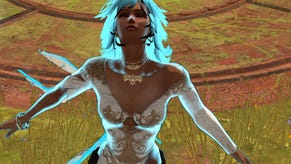Prince of Persia
A royal knockout?
If you don't want to see the button symbols, there's an option to turn them off. "But then you have to be able to recognise the animation, the sound effect, the visual cues, the filters, all of the other elements that combine to help you understand what particular button to press in that sequence," Mattes warns.
The other bad news for aggressive button-mashers is you won't get away with constant attacking - a good defence strategy is essential. In fact you're forced to adopt a defensive stance just to move around the floor at a decent pace. When the prince enters a combat situation he starts moving even more slowly than when he's walking normally; he only speeds up when he's adopting the block pose.
"There's a reason for that. Defence is extremely valuable in combat, and we need to teach people how valuable defence is in this combat system, because it's not in people's nature to fight defensively," says Mattes. "But this combat system is very generous towards a defensive style of gameplay. Some of the most advanced strategies in the game require a mastery of defence. We make the prince much faster, in terms of manoeuvring on the floor, when he's blocking than when he's in his default stance, to favour more defensive strategies."
If you're still having trouble, there's yet another strategy you can employ to take down enemies: Elika. You can command your sidekick to leap in and launch an attack with a single press of the Y button. It's a bit like having an extra weapon, and you can also chain her attacks together with your own. Elika's a helpful ally who's quick to respond to commands and never gets in the way.

She's also handy to have around when you're navigating levels. For example, pressing Y in the middle of a jump will make her take your hand and pull you to safety. If you're standing still, Y makes her release a glowing blue compass light that will trace out the path through the level for you. Purists might argue that the whole point of games like this should be working out the path from A to B for yourself, but you can always just ignore the compass power.
There are some issues, however, with how the prince and Elika interact. It comes back to the main problem with the opening cut-scene - the jarring inconsistencies between the beautiful, unique visual style, and the tired old script, storyline and relationships between characters. If Elika's so marvellously strong and acrobatic, why does the prince have to carry her on his back when climbing? Why does he end up carrying her in his arms during the opening sequence, while she simply remarks, "You really can put me down now"? You can't imagine Lara letting some bloke hoist her over his shoulder and prance about.

But Prince of Persia will by no means be the first or last videogame to feature rubbishy dialogue, and while it's easy to identify that sort of thing within half an hour (or the story - something about a "Tree of Life" and someone's Dad and "healing the fertile grounds to collect the light seeds then returning to the temple to purchase magic powers to unlock new areas"), the gameplay is a lot harder to judge.
The good news is that this is because it's so different to what you'd expect from the modern Prince of Persia series, and from action-adventure games in general. However, the question remains whether the shift towards strategy and slower-paced combat has been a wise decision, and we'll have to wait for longer than half an hour's play to figure that out.
Prince of Persia is due out for PS3, Xbox 360 and PC on 5th December.



